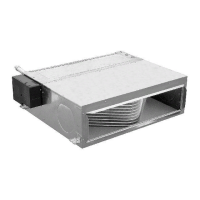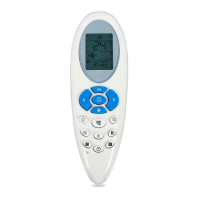4-262-10630
Figure 4-1. Belt Tension Gauge
(Carrier part Number 07--00203--00)
Belt tension depends on each kit. Refer to Installation
Instructions provided with the kit for belt tension
requirements. In each kit installation instruction, we
indicate the belt tension (given with belt tension gauge
P/N 07-00203-00.
When installing a new V-belt the tension should be
somewhat higher than specified and readjusted after
allowing the unit to run for some time.
4.3 EVAPORATOR COIL CLEANING
The use of recycled cardboard cartons is increasing.
Therecycledcardboardcartonscreatemuchmorefiber
dust during transport than ”new” cartons. The fiber dust
and particles are drawn into the evaporator where they
lodge between the evaporator fins. If the coil is not
cleaned on a regular basis, sometimes as often as after
each trip, the accumulation can be great enough to
restrict air flow, cause coil icing, repetitive defrosts and
loss of unit capacity. Due to the ”washing” action of
normal defrost the fiber dust and particles may not be
visible on the face of the coil but may accumulate deep
within.
It is recommended to clean an the evaporator coil on a
regular basis, not only to remove cardboard dust, but to
remove any grease oil film which sometimes coats the
fins andprevents water from draining intothe drainpan.
Cardboard fiber particles after being wetted and dried
several times can be very hard to remove. Therefore,
several washings may be necessary.
a. Spray coil with a mild detergent solution such as any
good commercial-grade automatic dish washer de-
tergent and let the solution stand for a few minutes.
Reverse flush (opposite normal air flow) with clean
water at mild pressure. A garden hose with spray
nozzle is usually sufficient. Make sure drain lines are
clean.
b. Run unit until defrost mode be initiated to check for
proper draining from drain pan.
4.4 CONDENSER COIL CLEANING
Remove all foreign material from the condenser coil by
reversingthenormalairflow .(Airis pulledinthroughthe
front.) Compressed air or water may be used as a
cleaning agent. It may be necessary to use warm water
mixedwithany goodcommercialdishwasherdetergent.
Rinse coil with fresh water if a detergent is used.
4.5 CHECKING AND REPLACING FILTER-DRIER
Checking filter-drier
Checkforanyobstructionofthefilter-drierbyfeelingthe
inlet andoutlet connections of the liquid line on the filter
cartridge. If the temperature of the outlet connection
seems lower than the temperature of the inlet
connection, replace the filter-drier.
Replacing the filter-drier
Pump the unit down(refer toparagraph 4.7.2). Remove
the drier mounting clip, then replace the filter-drier.
Following drier replacement, evacuate and recharge
unit (refer to paragraphs 4.9.4 & 4.10.3).
4.6 CHECKING THE TXV ORIFICE STRAINER
Pump the unit down(refer toparagraph 4.7.2). Remove
thebottom connection onthe TXV. Remove thestrainer
and check for obstruction or damage. Clean or replace
strainer assembly and tighten connection at bottom of
valve. Evacuate and recharge unit (refer to paragraphs
4.9.4 & 4.10.3).
Road compressor oil type:Theroadcompressorsare
supplied with CARRIER POLYESTER (POE) oil.
Ensure compressor is marked with a factory sticker
indicating the correct oil has been installed. Oils of PAG
typearestrictly incompatiblewiththeoperationofthis
unit, never use an oil other than that approved by
CARRIER.
4.7 REMOVING THE REFRIGERANT CHARGE
4.7.1 Removing Complete Charge
Connect a refrigerant recovery system to the unit to
removerefrigerant charge. Refertoinstructionprovided
by the manufacture of the refrigerant recovery system.
4.7.2 Pumping The Unit Down
If standby power is available and to service the
filter-drier, moisture-liquid indicator, liquid line check
valve, expansion valve, quench valve, evaporator coil,
compressor pressure regulating valve or the road
compressor pump the refrigerant into the high side as
follows:
a. Attach manifold gauge set to standby compressor
service valves.
b. Start the unit and run instandby cooling mode for 10
to 15 minutes. Frontseat the liquid line service valve.
PlacetheemergencyswitchintheOFFpositionwhen
the suction reaches a positive pressure of 1.0 psig
(0.01 bar).
c. Frontseat the standby suction service valve. The
refrigerant will be trapped between the standby com-
pressorsuctionservicevalveandtheliquid linevalve.
d. Before opening up any part of the system, a slight
positivepressure shouldbeindicatedonthepressure
gauge. If a vacuum is indicated, emit refrigerant by
crackingtheliquidlinevalvemomentarily tobuildupa
slight positive pressure.
e. When opening up the refrigerant system, certain
parts may frost. Allow the part to warm to ambient
temperature before dismantling. This avoids internal
condensation which puts moisture in the system.

